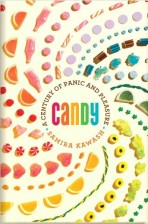Candy Cookery
May 10, 2010 at 8:28 am 2 comments
In a simpler time, advice for the homemaker could include these sweet words:
Candy has been discovered by home economists to be an all-day food. From candy-coated cereals for breakfast to a midnight nibble, there is no moment of the day when candy can’t be used to fit into pleasant times.
These encouraging words occur midway through a chapter titled “Candy in the Home,” the final chapter in an 1958 NCA volume titled All about Candy. Candy, the author promises, will “contribute an unique aesthetic and artistic enjoyment to the home and to family living.”
And what does that enjoyment look like?
Candy for dessert is a no-brainer. How about the candy-and-fruit tray? or the “Scout soda,” that would be an orange with a candy stick stuck in for sipping. Another suggestion is “Strawberries Pastel”: lovely fresh strawberries surrounding a mound of pulverized after-dinner mints. Dip you strawberry in the mint–Delicious!
But don’t think candy can’t come to your aid through the rest of the meal. Meat and vegetable sauces? You bet. Try candy mints to flavor your lamb sauce. Crushed peanut brittle in your cole slaw. Candy sauce for carrots. And although it goes unmentioned in “Candy in the Home,” I’m sure there’s something you can do with those cinnamon red hots.
As for baked goods, breakfast will never be the same. The author has such novelties in mind as these: Crush some hard candies to top your crescent rolls. Melt some caramels for extra-sweet caramel pecan rolls. Or how about cinnamon-apple coffee cake with chopped up gum drops mixed into the batter? It’s for “breakfast, lunch or snacking any time.”
All of these seem a little surprising to today’s palette. On the other hand, many of the “novel” uses for candy suggested in this chapter are by now so ordinary that we barely recognize them. Cakes and cookies, especially those made for children, are frequently decorated with colorful candies like gum drops, jelly beans, or M&Ms. Hard to believe it, but there was a time when no one would have thought to mix candy and cake. Adding chopped chocolate, chocolate chips, or even chopped candy to any kind of cake or cookie seems today pretty obvious. Back then, the author found need of extensive explanation and justification for this “dressing up.” Candy as a topping for ice cream was once a big surprise; today, it’s hard to find ice cream that doesn’t have candy mixed in.
It’s hard to believe, but fifty years ago it was not obvious that Easter Egg hunts were hunting for candy, so the author has to spell it out: “A place where candy can be used in numerous ways is for a children’s party. . . Easter egg hunts, Fourth of July celebrations, almost any time children are gathered together are also good times to make use of candy.”
Source: “Candy in the Home,” chapter 8 of All About Candy and Chocolate by Philip Gott (NCA, 1958).
Entry filed under: Candy as Food, Ingredients.
2 Comments Add your own
Leave a comment
Trackback this post | Subscribe to the comments via RSS Feed

1. News Brief: Cooking with See’s Candy « Candy Professor | May 30, 2010 at 8:33 am
[…] Now that’s candy cookery. […]
2. Candy Salad (Marshmallow Chronicles, Part IV) « Candy Professor | June 23, 2010 at 8:03 am
[…] trends and attitudes that would pave the way for a new phenomenon that flourished at mid-century: Candy Cookery. The marshmallow was just the […]